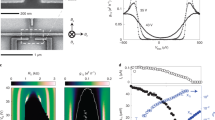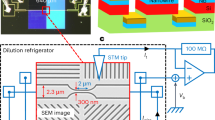Abstract
Superconducting devices, based on the Cooper pairing of electrons, play an important role in existing and emergent technologies, ranging from radiation detectors1,2 to quantum computers3. Their performance is limited by spurious quasiparticle excitations formed from broken Cooper pairs4,5,6,7,8,9,10,11,12. Efforts to achieve ultra-low quasiparticle densities have reached time-averaged numbers of excitations on the order of one in state-of-the-art devices2,12,13,14,15. However, the dynamics of the quasiparticle population as well as the timescales for adding and removing individual excitations remain largely unexplored. Here, we experimentally demonstrate a superconductor completely free of quasiparticles for periods lasting up to seconds. We monitor the quasiparticle number on a mesoscopic superconductor in real time by measuring the charge tunnelling to a normal metal contact. Quiet, excitation-free periods are interrupted by random-in-time Cooper pair breaking events, followed by a burst of charge tunnelling within a millisecond. Our results demonstrate the possibility of operating devices without quasiparticles with potentially improved performance. In addition, our experiment probes the origins of nonequilibrium quasiparticles in our device. The decay of the Cooper pair breaking rate over several weeks following the initial cooldown rules out processes arising from cosmic or long-lived radioactive sources16,17,18,19.
This is a preview of subscription content, access via your institution
Access options
Access Nature and 54 other Nature Portfolio journals
Get Nature+, our best-value online-access subscription
$29.99 / 30 days
cancel any time
Subscribe to this journal
Receive 12 print issues and online access
$209.00 per year
only $17.42 per issue
Buy this article
- Purchase on Springer Link
- Instant access to full article PDF
Prices may be subject to local taxes which are calculated during checkout




Similar content being viewed by others
Data availability
Data for figures that support the manuscript are available at https://doi.org/10.5281/zenodo.5574415. All other data that support the findings of this study are available from the corresponding author upon reasonable request.
References
Day, P. K., LeDuc, H. G., Mazin, B. A., Vayonakis, A. & Zmuidzinas, J. A broadband superconducting detector suitable for use in large arrays. Nature 425, 817 (2003).
Echternach, P. M., Pepper, B. J., Reck, T. & Bradford, C. M. Single photon detection of 1.5 THz radiation with the quantum capacitance detector. Nat. Astron. 2, 90 (2018).
Kjaergaard, M. et al. Superconducting qubits: current state of play. Annu. Rev. Condens. Matter Phys. 11, 369 (2020).
Aumentado, J., Keller, M. W., Martinis, J. M. & Devoret, M. H. Nonequilibrium quasiparticles and 2e periodicity in single-Cooper-pair transistors. Phys. Rev. Lett. 92, 066802 (2004).
Shaw, M. D., Lutchyn, R. M., Delsing, P. & Echternach, P. M. Kinetics of nonequilibrium quasiparticle tunneling in superconducting charge qubits. Phys. Rev. B 78, 024503 (2008).
de Visser, P. J. et al. Number fluctuations of sparse quasiparticles in a superconductor. Phys. Rev. Lett. 106, 167004 (2011).
Martinis, J. M., Ansmann, M. & Aumentado, J. Energy decay in superconducting Josephson-junction qubits from nonequilibrium quasiparticle excitations. Phys. Rev. Lett. 103, 097002 (2009).
Catelani, G. et al. Quasiparticle relaxation of superconducting qubits in the presence of flux. Phys. Rev. Lett. 106, 077002 (2011).
Pop, I. M. et al. Coherent suppression of electromagnetic dissipation due to superconducting quasiparticles. Nature 508, 369 (2014).
Wang, C. et al. Measurement and control of quasiparticle dynamics in a superconducting qubit. Nat. Commun. 5, 5836 (2014).
Patel, U., Pechenezhskiy, I. V., Plourde, B. L. T., Vavilov, M. G. & McDermott, R. Phonon-mediated quasiparticle poisoning of superconducting microwave resonators. Phys. Rev. B 96, 220501(R) (2017).
Gustavsson, S. et al. Suppressing relaxation in superconducting qubits by quasiparticle pumping. Science 354, 1573 (2016).
Ferguson, A. J. Quasiparticle cooling of a single Cooper pair transistor. Appl. Phys. Lett. 93, 052501 (2008).
Higginbotham, A. P. et al. Parity lifetime of bound states in a proximitized semiconductor nanowire. Nat. Phys. 11, 1017 (2015).
Vool, U. et al. Non-Poissonian quantum jumps of a fluxonium qubit due to quasiparticle excitations. Phys. Rev. Lett. 113, 247001 (2014).
Vepsäläinen, A. et al. Impact of ionizing radiation on superconducting qubit coherence. Nature 584, 551 (2020).
Cardani, L. et al. Reducing the impact of radioactivity on quantum circuits in a deep-underground facility. Nat. Commun. 12, 2733 (2021).
Wilen, C. D. et al. Correlated charge noise and relaxation errors in superconducting qubits. Nature 594, 369 (2021).
Martinis, J. M. Saving superconducting quantum processors from qubit decay and correlated errors generated by gamma and cosmic rays. npj Quantum Inf. 7, 90 (2021).
Wilson, C. M., Frunzio, L. & Prober, D. E. Time-resolved measurements of thermodynamic fluctuations of the particle number in a nondegenerate Fermi gas. Phys. Rev. Lett. 87, 067004 (2001).
Lambert, N. J. et al. Experimental observation of the breaking and recombination of single Cooper pairs. Phys. Rev. B 90, 140503 (2014).
Serniak, K. et al. Direct dispersive monitoring of charge parity in offset-charge-sensitive transmons. Phys. Rev. Appl. 12, 014052 (2019).
Van Woerkom, D. J., Geresdi, A. & Kouwenhoven, L. P. One minute parity lifetime of a NbTiN Cooper-pair transistor. Nat. Phys. 11, 547 (2015).
Hays, M. et al. Direct microwave measurement of Andreev-bound-state dynamics in a semiconductor-nanowire Josephson junction. Phys. Rev. Lett. 121, 047001 (2018).
Karzig, T., Cole, W. S. & Pikulin, D. I. Quasiparticle poisoning of Majorana qubits. Phys. Rev. Lett. 126, 057702 (2021).
Barends, R. et al. Minimizing quasiparticle generation from stray infrared light in superconducting quantum circuits. Appl. Phys. Lett. 99, 113507 (2011).
Saira, O.-P., Kemppinen, A., Maisi, V. F. & Pekola, J. P. Vanishing quasiparticle density in a hybrid Al/Cu/Al single-electron transistor. Phys. Rev. B 85, 012504 (2012).
Maisi, V. F. et al. Excitation of single quasiparticles in a small superconducting Al island connected to normal-metal leads by tunnel junctions. Phys. Rev. Lett. 111, 147001 (2013).
Pobell, F. Matter and Methods at Low Temperatures 3rd edn (Springer-Verlag, 2007).
Pekola, J. P. et al. Environment-assisted tunneling as an origin of the Dynes density of states. Phys. Rev. Lett. 105, 026803 (2010).
Koski, J. V., Peltonen, J. T., Meschke, M. & Pekola, J. P. Laterally proximized aluminum tunnel junctions. Appl. Phys. Lett. 98, 203501 (2011).
Zorin, A. B. The thermocoax cable as the microwave frequency filter for single electron circuits. Rev. Sci. Instrum. 66, 4296 (1995).
Schoelkopf, R. J., Wahlgren, P., Kozhevnikov, A. A., Delsing, P. & Prober, D. E. The radio-frequency single-electron transistor (RF-SET): a fast and ultrasensitive electrometer. Science 280, 1238 (1998).
Simbierowicz, S. et al. A flux-driven Josephson parametric amplifier for sub-GHz frequencies fabricated with side-wall passivated spacer junction technology. Superconductor Sci. Technol. 31, 105001 (2018).
Acknowledgements
The authors thank O. Maillet for useful discussions, J. Ala-Heikkilä for support with shielding solutions and J. Lehtinen and M. Prunnila from VTT Technical Research Center of Finland Ltd., who were also involved in the JPA development. This work was performed as part of the Academy of Finland Centre of Excellence program (projects 312057, 312059 and 312294). We acknowledge the provision of facilities and technical support by Aalto University at OtaNano - Micronova Nanofabrication Centre and OtaNano - Low Temperature Laboratory. E.T.M. and J.P.P. acknowledge financial support from Microsoft. V.V. acknowledges financial support from the Academy of Finland through grant no. 321700. P.S. and V.F.M. acknowledge financial support from the Swedish National Science Foundation, and V.F.M. acknowledges financial support from the QuantERA project ‘2D hybrid materials as a platform for topological quantum computing’ and NanoLund.
Author information
Authors and Affiliations
Contributions
E.T.M., P.S., V.F.M. and J.P.P. conceived the experiment and model and interpreted the results. E.T.M. fabricated the sample and performed the experiment with support from J.T.P., and E.T.M. analysed the data. P.S. performed the theoretical modelling. S.S., V.V., L.G. and J.H. provided the Josephson parametric amplifier. E.T.M. and J.T.P. integrated the Josephson parametric amplifier into the set-up with assistance from S.S. and V.V. The manuscript was written by E.T.M. and P.S. with input from all coauthors.
Corresponding author
Ethics declarations
Competing interests
The authors declare no competing interests.
Additional information
Peer review information Nature Physics thanks the anonymous reviewers for their contribution to the peer review of this work
Publisher’s note Springer Nature remains neutral with regard to jurisdictional claims in published maps and institutional affiliations.
Supplementary information
Supplementary information
Supplementary Notes 1–8 and Figs. S1–S13.
Rights and permissions
About this article
Cite this article
Mannila, E.T., Samuelsson, P., Simbierowicz, S. et al. A superconductor free of quasiparticles for seconds. Nat. Phys. 18, 145–148 (2022). https://doi.org/10.1038/s41567-021-01433-7
Received:
Accepted:
Published:
Issue Date:
DOI: https://doi.org/10.1038/s41567-021-01433-7
This article is cited by
-
A secret source
Nature Physics (2022)
-
Engineering superconducting qubits to reduce quasiparticles and charge noise
Nature Communications (2022)



